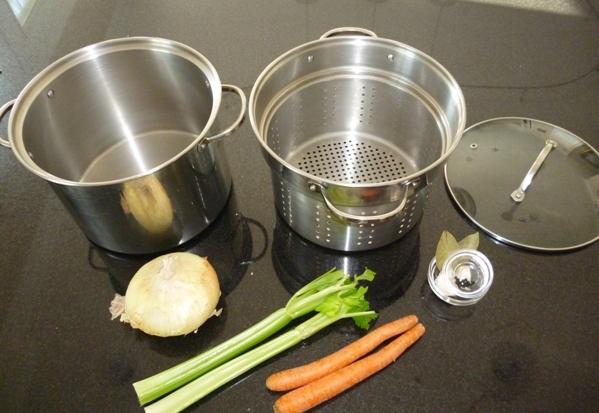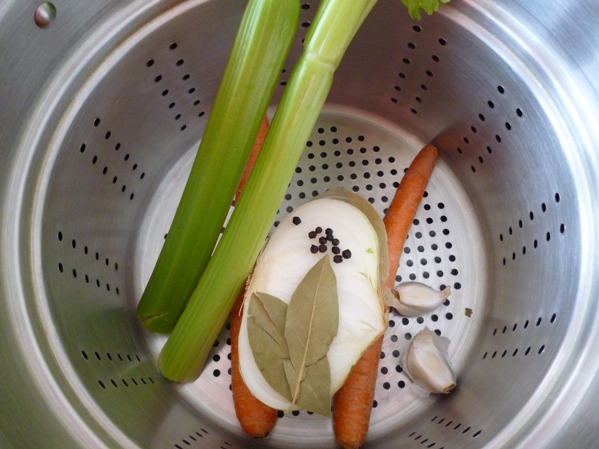Make Stock First
 Sunday, January 22, 2012 at 10:30AM
Sunday, January 22, 2012 at 10:30AM  Margot
Margot 
Why?
If you have stock, you can do pretty much anything with it. And if you have homemade stock, your recipes will taste like they came out of a five star restaurant. Because that’s the secret that makes anything a restaurant prepares taste better. It’s what rock star chefs have their kitchen minions do for them: make stock on a daily basis.
And, its free (or almost). At least the way I make it.
I’ve tried nearly every commercially prepared stock out there. There is a back flavor to each one of them that comes through the dish. Don’t know if it is because it’s in a can, or box, or somewhere along the line, the recipe has some type of artificially concentrated flavoring or bouillion in it, but it’s there. They also have a one-note complexity that, when combined with that back flavor and reduced makes for odd or bland tasting soups and sauces.
So, here is my method for making stock. Doesn’t really matter what kind it is.
Meats, Fish, Shellfish, or Vegetables which are your primary flavor. (but not all at once, please.)
I have found using cooked ingredients for this component works best. There is an additional layer of flavor and complexity that comes from using something that has already been cooked. I have seen recipes calling for a whole chicken or two to make stock. Expensive. The meat isn't really very good when it has been cooked this long. And, I don’t like the taste. It tastes raw or let’s face it, boiled. Even though it’s poached or simmered. Sorry Ina.
Guess what? That means you can use leftovers:
- You can respectably ask for doggie bags in restaurants.
- You can, and you should, use all of those bones and scraps that were leftover from a chicken or roast you cooked. Why not, you paid for them?
- You can use the bones and scraps from anything out of the grocey store rotisserie. You paid for those, too.
- Ok, so don't use the bones you or your guests have knawed on.
- Throw them in a bag and put them in the freezerJust remember to label what they are and put a date on them. They stay for about 3 months.
I combine both pork and beef scrapes together for a general brown stock, chicken for chicken, turkey for turkey. For seafood, the shells and any other fish scraps you have. And for vegetable stock, I roast whatever I need first, or use any leftover roast vegetables.
For a batch of stock yielding about 3-4 quarts, you need at least the equivalent of bones from one chicken, 3-4 steak or chop bones. In general, a pound or two of meat bones and scraps will suffice. Use more if you have it, as long as you can fit everything into your pan.
Onions, Carrots, Celery and Garlic.
YOU NEED ALL FOUR.
I’ve tried to make stock when I was missing one. Not good. Not awful, but not balanced. The good news is that when you have these items in your vegetable bin and they are a bit past their prime, just throw them in a bag in the freezer and use them for stock. So:
- One medium onion
- Two stalks celery
- Two medium carrots
- Two whole garlic cloves
Just cut off the and root ends or wash to eliminate dirt, cut into a couple of pieces each, and throw them in the pot. Put the garlic in whole. See? Easy.
Bay Leaf and Whole Black Pepper Corns.
One or two Bay leaves and 8-10 peppercorns, whole. Don’t know why these work, they just do. It’s a balance thing again. Just leave out the Black Pepper Corns if you are making a light stock, such as vegetable or fish or shellfish.
Water
If you have good water coming out of your tap, use it. If you don’t like the taste of water that comes out of your tap, you probably won’t like the taste of your stock (or your coffee). So use what you would normally drink. If that is a filtered source, out of your refrigerator or tap, or a $1.00 gallon bottle of spring water, any of those would work.

The How To
- Put everything in a large pot. Twelve quarts if you have one that big. Cover with water (as much as you can fit).
- Bring to a boil, drop to the heat down to a slow boil, and let it go for two hours.
- Strain ou the bones and vegetables and discard them. You read right: dump them. Do you really want to eat something that has been boiling for two hours?
- Refridge in the pot overnight. The next day, skim off the fat and freeze in 1 quart containers. Fill an ice cube tray with whatever is left over.
- Once the tray is frozen, remove the cubes to a plastic bag.
You may now begin cooking.
You will taste the difference in any soup, any braised dish, any chile, anything you make. One or two of the cubes added to your gravy or pan sauté will make all of the difference in the world.

Reader Comments